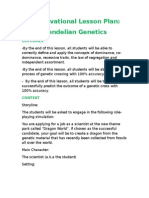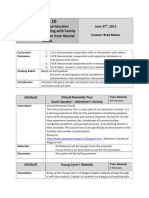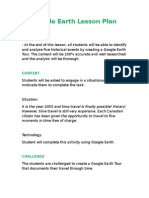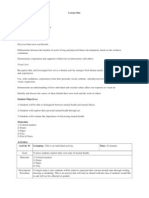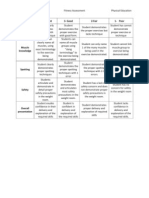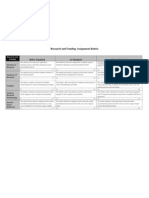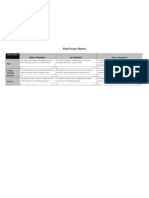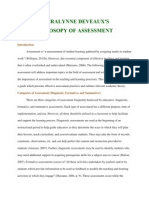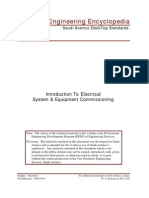Validation of A Learning Object Review
Validation of A Learning Object Review
Uploaded by
api-143975079Copyright:
Available Formats
Validation of A Learning Object Review
Validation of A Learning Object Review
Uploaded by
api-143975079Original Title
Copyright
Available Formats
Share this document
Did you find this document useful?
Is this content inappropriate?
Copyright:
Available Formats
Validation of A Learning Object Review
Validation of A Learning Object Review
Uploaded by
api-143975079Copyright:
Available Formats
Interdisciplinary Journal of E-Learning and Learning Obj ects
Volume 4, 2008
Formerl y the Inter disciplinar y Journal of Knowl edge and Learning Objects
Validation of a Learning Object Review
Instrument: Relationship between Ratings of
Learning Objects and Actual Learning Outcomes
Yavuz Akpinar
Bogazici University, Department of Computer Education and
Educational Technology, Istanbul, Turkey
Akpinar@boun.edu.tr
Abstract
Growing interest in learning objects (LOs) as a means of developing learning materials is leading
to mainline LO evaluation methodologies using review instruments, such as evaluation rubrics, to
suit various practical purposes. Such evaluation tools give evidence about the design and the
value of the LOs, and studies performed with actual users can provide data against which these
expectations of the effects of LOs on student achievements in practice can be set. This study presents a validation of a learning object review instrument (LORI) with student users (n=507) of
twenty-four LOs used in K-12 environments. T he data collected through pre- and post-tests,
teachers and students usability questionnaires, and the LORI revealed some interactions between those variables. However, the LORI ratings, and the usability assessments did not correlate
with the learning gains of students. Some implications of these findings are discussed.
Ke ywords: Learning objects, learning outcome, LORI, validation.
Introduction
To meet diverse learning needs and to improve student learning, a variety of resources, often including digital media, are developed where the combination of the media and methods of use
change with context and try to take account of student differences. New technologies have
emerged to assist these objectives, and one method of designing and presenting computer based
educational materials is that of learning objects (LOs), usually defined as any digital resource that
can be reused to support learning (Wiley, 2000). Examples of such digital resources that can be
employed within instructional materials include images or photos, live data feeds, live or prerecorded video or audio snippets, text, animations, and web-delivered applications such as a Java
applet, a blog, or a web page combining text, images and other media. Thus LO approaches can
be wide-ranging and offer new possibilities to access and reuse online materials (Wiley, 2005).
Online repositories storing large numbers of LOs, which different user groups
Material published as part of this publication, either on-line or
(e.g. teachers, instructional designers,
in print, is copyrighted by the Informing Science Institute.
material producers, and learners) can
P ermission to make digital or paper copy of part or all of these
works for personal or classroom use is granted without fee
access and employ in various contexts
provided that the copies are not made or distributed for profit
according to their needs, can, in princior commercial advantage AND that copies 1) bear this notice
ple, bring economy and variety into the
in full and 2) give the full citation on the first page. It is pereducational process (Nurmi & Jaakkola,
missible to abstract these works so long as credit is given. To
copy in all other cases or to republish or to post on a server or
2006a). However, although LOs can
to redistribute to lists requires specific permission and payment
provide stimulating opportunities to imof a fee. Contact 0HPublisher@InformingScience.org to reprove educational practices, to extend
quest redistribution permission.
Editor: Heinz Dreher
Validation of a Learning Object Review Instrument
the use of digital technologies in schools and to reduce the time required to prepare technology
enhanced teaching, many associated problems and practical shortcomings can arise (Akpinar &
Simsek, 2007; Jonassen & Churchill, 2004; Kay & Knaack, 2007; Li, Nesbit & Richards, 2006;
Nurmi & Jaakkola, 2005; Parrish, 2004; Strijker, 2004; Vuorikari, Manouselis, & Duval, 2006).
There is a lack of empirical evidence on the effectiveness of LOs, though this has not reduced the
interest in the technique, and indeed it provides an incentive for further research.
Whilst the LO debate continues (Churchill, 2007; Cochrane, 2005; Friesen, 2005; Krauss & Ally,
2005; Maceviciute & Wilson, 2008; Merrill, 2001; Parrish, 2004; Polsani, 2003; Salas & Ellis,
2006; Varlamis & Apostolakis, 2006; Wiley, 2000), the effectiveness of LOs is likely to be limited if they do not conform to established design principles and have not been subjected to formative user testing (Li et al., 2006). A range of different evaluation approaches for such learning
resources exists, and Vuorikari et al. (2006) studied and analyzed a sample of thirteen evaluation
approaches either currently applied to learning object repositories (LORs) or used as general
quality guidelines for digital learning resources. These approaches were distinguished in terms of:
(1) methodological characteristics focusing on the process or the product;
(2) the stage of the learning resource lifecycle focusing on developmental guidelines or enduser evaluation ratings;
(3) the educational processes or optimization parts of the development lifecycle;
(4) the form of evaluation instruments used, e.g. questionnaires, a list of criteria or certification instruments;
(5) the audience as developers, evaluators, subject experts, teachers, or end users;
(6) the criteria or metrics engaged by the tools; and
(7) the characteristics of the environment in which evaluation approach is expected to be applied.
Also, a recent survey (T zikopoulos, Manouselis, & Vuorikari, 2007) reported on 23 highlighted
evaluation and rating approaches. Because there is such diversity in the goals and forms of LO
evaluations, Dron, Boyle, and Mitchell (2002) and Vuorikari et al. (2006) suggest the use of
tagged metadata for storing the results of such evaluations, not only noting data on sharing and
reusability, but summarizing the experience and achievements LO resources in use.
Learning Object Evaluation Instruments
The mainline LO evaluation methodologies use review instruments such as evaluation rubrics, of
which the most cited is the Learning Object Review Instrument (LORI) developed by Vargo,
Nesbit, Belfer, and Archambault (2003) and improved by Nesbit and Li (2004). LORI 1.5 uses
nine items with brief descriptive rubrics associated with each item. The items and what they
measure may be outlined as:
(1) Content Quality: The LO content is free of error and presented without bias. Claims are
supported by logical arguments, and presentations highlight significant ideas.
(2) Learning Goal Alignment: Appropriate learning goals are stated. The learning activities,
content, and assessments provided by the LO align with the declared goals.
(3) Feedback and Adaptation: The LO provides feedback driven by differing learner inputs or
learner modeling.
(4) Motivation: The LO content is relevant to the personal goals and interests of the intended
learners.
(5) Presentation Design: The style of information design in the LO enables users to learn efficiently. T he presentations of the LO minimize visual search; text and graphics are clear, concise and free of errors. Screen components do not interfere with learning goals.
(6) Interaction Usability: The user interface design implicitly informs learners about how to
292
Akpinar
interact with the LO. Navigation through the LO is simple. The behavior of the user interface
is consistent and predictable.
(7) Accessibility: The design of controls and presentation formats in the LO may accommodate learners with sensory and motor disabilities. The LO can be accessed through different
electronic means including assistive and highly portable devices.
(8) Reusability: T he LO is a stand-alone resource that can be readily transferred to different
courses, learning designs, and contexts.
(9) Standards Compliance: The LO conforms to relevant international standards and specifications. Sufficient metadata is provided in tagged codes and made available to users.
LORI 1.5 uses a Likert-style five point response scale with the items ranging from low (1) to high
(5). If an item is judged not relevant to the LO, or if the reviewer does not feel qualified to judge
that criterion, then the reviewer may opt out of the item by selecting not applicable. But the
convergent evaluation model used in the LORI is criticized by Kay and Knaack (2007), who note
that it is usually limited by the small number of participants giving feedback, and its final evaluation may not be representative of what a larger population might observe or experience.
To review LOs for acceptance in one of the largest LO repositories, MERLOT (www.merlot.org),
adopted many of the same criteria used by the LORI. The Merlot process employs both individual
evaluation (peer review) and referral to standards for learning objects. The standards or guidelines
are an attempt to help reviewers assess materials submitted by developers, and the criteria used by
Merlot reviewers fall into three broad areas: T he quality of content, the potential effectiveness as
a teaching-learning tool, and the ease of use. T he Merlot scale uses a continuum from one star
denoting material not worthy of use to a five star rating representing excellence all around.
Like the LORI process, reviewers are taken from the subject discipline of the LO content. T he
Collaborative Learning Object Exchange (CLOE) of Canada has also built up a peer review process for LOs to be included in a provincial LO repository. T his process closely follows the Merlot
criteria but differs in the range and number of questions used. T he Merlot criteria employ a set of
more than 30 individual questions requiring detailed answers, while the CLOE criteria use 14
items. In brief, reviewers (i.e. instructional designers and subject matter experts) are asked to
evaluate the LOs on the quality of their content, their effectiveness as a teaching tool, and their
ease of use. Finally, Haughey and Muirhead (2005) proposed a further evaluation instrument,
Learning Object Evaluation Instrument (LOEI), which was developed from the previous three
instruments. The scales used in evaluating each LO component are not meant to provide comparisons, but to allow reviewers to assess the integrity, usability, learning, design, and value focus of
each learning object.
Although the LO repositories commonly use these review instruments, only a limited number of
empirical studies have examined the learning outcomes and the instructional effectiveness of
LOs. By using LO survey tools, Kay and Knaack (2005, 2007) examined the quality of LOs
through content analysis of open-ended response questions based on principles of instructional
design and perceived benefit under post-hoc structured categories. They evaluated 5 learning objects with 220 secondary school students, in grades 9-12, with 30 teachers. The evaluation data
were collected after the sample used the LOs either as an introduction to the learning of concepts
in the subject matter area or as support material to the teachers activities. The data collection
tools included interviews with teachers and two surveys collecting comments of students and
teachers. The results showed that two-thirds of all students felt that LOs were beneficial, particularly when they had a motivating theme, visual supports, and interactivity. Also, both experienced
and pre-service teachers confirmed the student reports. However, this study focused on perceived
benefits of LOs rather than on the actual learning outcomes resulting from the LO activities.
McCormick and Li (2006) also studied 770 teachers views and experiences of using LOs in
CELEBRAT E (a research and development project dealing with LO development and implemen-
293
Validation of a Learning Object Review Instrument
tation funded by the European Union) through online surveys, routine data collected from the
CELEBRAT E portal, and semi-structured interviews in 40 schools in 6 different countries. The
study showed a generally positive reaction to the use of LOs by the teachers as a support for
teaching and learning. However, it was noted that teachers used the LOs in a variety of contrasting ways, and that they tended superimpose their own pedagogy, whatever the designed pedagogy
of the LO. Hence it appeared that granularity and interoperability characteristics were significant
in rating LOs as useful, particularly where they supported resource-based learning. However,
both of the studies reviewed suggested the need for further evaluation tools, methods, and research to identify the actual effects of LOs on learning processes and outcomes.
In this respect, Nurmi and Jaakkola (2006b) conducted an experimental study using a pre-testpost-test design to evaluate the effectiveness of three LOs from three different subject areas, i.e.
Mathematics, Finnish Language and Science. T he LOs, tested with school children, were used in
different instructional settings. T he results revealed that in Mathematics and in Finnish students
following traditional teaching conditions achieved slightly better results on subject matter posttests and developed more learning gains than students following the LO conditions, though these
differences were not statistically significant. Also, no significant differences were observed between the LO and the traditional teaching conditions with low and high prior knowledge students.
In the Science LO study, students in the mixed condition, where both LO and laboratory activities
were used together, significantly outperformed those in the traditional teaching condition. T he
study concluded that, to be successful, LOs require carefully designed learning environments and
instructional arrangements around them.
In a design similar to the Nurmi and Jaakkola (2006b) study, Akpinar and Simsek (2007) tested 8
LOs, whose overall LORI scores varied from 30 to 36 out of a maximum of 45, with 180 school
children in a pre-post test research design. The data analysis revealed that 7 of the LOs helped the
sample students improve their pretest scores, but in one, the Horizontal Projectile Motion (HRM)
LO for ninth grade students, the scores did not improve. It seemed that this detrimental effect may
have stemmed from the fact that HRM is a topic in which many students have misconceptions
(T ao & Gunstone, 1999) that the LO was unable to correct.
The Validation Study
In the evaluation of LOs, interested participants include selected subject matter experts, designers, and the actual users of the materials. All can provide helpful information for LO developers
and other users, and understanding the interactions between them is critical to the practical applications of LOs. The study reported in this paper set out to author interactive LOs (bearing in mind
design principles of interface clarity, consistency of naming, and interactivity) and, against these,
to validate a learning object review instrument (the LORI v1.5 by Nesbit and Li, 2004) with
teacher and student users of the LOs in a variety of K-12 contexts. Further, and in particular, the
following research questions were examined:
(1) Whether the reviewers ratings of the LOs on the basis of individual LORI items and total
LORI scores for each LO interact with (a) the scores of teachers answering the usability test,
(b) the students scores on the usability test, and (c) the learning outcomes of the students
measured by post- and pre-test differences.
(2) Whether learning outcomes of the resulting LOs differ in terms of (a) their scores on the
individual LORI criteria and (b) the overall LORI assessments.
Sample
The sample for the LO evaluation studies consisted of a total of 507 elementary and secondary
school students and their 24 teachers. The students grades varied from 4 (age of 11) to 10 (age of
294
Akpinar
17). The twenty-four LOs, (one in Biology, three in Chemistry, three in Mathematics, three in
Physics and fourteen in General Science) whose development procedure is given below, were
studied by 24 groups. T he group size varied between 15 and 54 students.
Materials and Procedure
To validate the LORI, a series of LOs were authored by 26 senior instructional design students at
the beginning of the spring semester of 2007. These senior students were taking their BSc. degree
in four years at the Department of Computer Education and Educational Technology. In their
previous courses, the students had completed instructional design and development projects in
computer based instruction (CBI) and all had programmed and produced CBI designs and materials. T he students were also taking a courseware development and evaluation course and contributed to this study as part of that course. Specifically they were asked to be authors and to develop
a series of LOs to facilitate learning in a unit they selected from K-12 contexts. The interactive
and problem based LOs had to fulfill the following requirements (Akpinar & Hartley, 1996):
The designed LO components, and sharable content objects (SCOs) should be sequenced in a certain order so that the LO they constitute forms a coherent scenario.
The scenario must make sense for the target students and employ their previous knowledge to help them overcome learning difficulties.
The SCOs must have particular tools to enhance interactivity by encouraging students
to try out their ideas and allowing them to learn from their mistakes.
The SCOs must have facilities to concretize the content and to respond to individual
differences in knowledge and experience.
The LO facilities and scenario must give clear objectives and feedback to students and
motivate them through challenging tasks.
The sequence of SCOs must move from concrete to abstract and draw on appropriate
knowledge representations.
Following their LO initial design activities, the authors met under the supervision of the researcher to discuss their design features and justify the screen components they proposed. The
discussions focused on the rationalization of the SCOs in the LOs and their contribution to overcoming specified learning difficulties in the selected learning tasks. During these meetings, the
LO authors discussed their design ideas with other students to receive their advice. Authors completed programming their LO specification using the MM Flash platform. All activities in a LO
were designed and implemented in a way that they can work as a stand-alone application. Each
activity with all its assets may be used independently, taken into a different application, or embedde d into some other LOs or even SCOs. The LO authors exchanged the assets of each others
LOs (e.g. images, animations, counters) in implementation of LOs where appropriate. Each developed LO was then evaluated by at least 10 peer reviewers (other LO authors) and by the researcher using LORI 1.5. These raters scores for a particular LO were then averaged for each
item (i.e. theme) of the LORI.
To test whether the developed (and LORI reviewed) LOs were able to effect learning outcomes
when used by the target pupils and to validate the LORI in actual learning environments, a series
of classroom tests were designed. First, each LO author developed two achievement tests as pretest and posttest, containing parallel items in order to examine the possible contribution of the
LOs to student achievement. Then each LO author developed LO usability questionnaires: one for
students and one for teachers. These investigated whether the implemented LO was easy to use
and understand and asked (using numbers of items expressed in suitable language) whether stu-
295
Validation of a Learning Object Review Instrument
dents approved the screen design, the text and picture orientation, the interactive mechanisms,
and the tools used in the LO. These questionnaires all Likert type scales. Those for elementary
school students had three choices: disagree, neutral, and agree; the other student questionnaires
had five choices: strongly disagree, disagree, neutral, agree, and strongly agree. Likewise the usability questionnaires for teachers contained five-point Likert type items seeking teachers opinions on the screen components and instructional facilities of a particular LO.
Both the pre/post tests and the usability questionnaires were reviewed, corrected, and verified by
the researcher, by an expert instructional designer, and by one of the appropriate peers. For the
classroom applications of the LOs, local schools were contacted for their agreement to participate, and with this permission the LO authors administered the pretests to the designated students.
[T wo of the twenty-six LOs were not used because their content had already been used in trialing
studies.]
The authors of the LOs demonstrated the LOs and explained to the class teachers how the LOs
worked, and the teachers were told there should be minimal teacher intervention during the students working with the LOs. The authors then installed their LOs into the computer labs of the
schools where they explained to the students and their class teacher how the LOs were to be used
in the study sessions. These introductions of the LOs took 10-20 minutes, and the students and
the teachers questions were also answered. T he students then started to work with the LOs.
Whilst the students studied an LO, the LO author and the class teacher monitored students work.
All students studied the LOs individually. To enable interaction and active participation, each LO
presented task activities for the students to accomplish using the tools available in the LO. For
example, the LO about the separation of mixtures for seventh graders asked students to play the
role of a chemist and to separate mixed substances by selecting and using the given tools, such as
a strainer, ventilator, boiler, distiller, or burner. The students progress, moving from one task to
the next, depended on their performance over the tasks. If mistakes were made, then system feedback enabled students to correct these errors before moving on to the next task The LOs also contained help features related to the activities. The students study sessions for an LO took between
20 and 65 minutes. Only two studies were carried out in multiple sessions due to large number of
participants in the classes, one of which had 33 students organized in two sessions, and another of
which had 54 students organized in three sessions. Following the study with the LOs, the posttests and the usability questionnaires were administered to the students: In ten of the studies they
were administered just after the LO study; in all others they were administered the next day. All
the studies were completed within a two weeks time period. T able 1 presents a summary of the
data.
Table 1: A summary statistics of the studies
LO Content
Science
(Nutrition &Its
Agents)
Mathematics
(Functions)
Science
(Separation of
Mixtures)
Science
(H. Motion)
Biology
(Animal Cell)
Science
(Change in Matter)
296
Overall Teachers Students
Post# of
Sample
Grade/Age Activity LORI Usability Usability
Pretest
size
Score
Test
Test
Difference
Statistical
test
Effect size
Cohens d
5/12
39.16
0.80
0.80
22.40
21
0.00**
1.45
9/16
26
34.44
0.81
0.80
21.93
22
0.00**
1.31
7/14
12
39.92
0.89
0.88
18.00
20
0.00**
1.09
7/14
18
36.10
0.86
0.90
18.50
20
0.00**
1.08
9/16
13
32.83
0.74
0.80
30.39
19
0.00**
1.05
7/14
29.86
0.60
0.55
14.21
19
0.00**
1.02
Akpinar
LO Content
Overall Teachers Students
Post# of
Sample
Grade/Age Activity LORI Usability Usability
Pretest
size
Score
Test
Test
Difference
Mathematics
7/14
12
(Ratio)
Science
7/14
10
(Atoms)
Chemistry
9/16
11
(Reactions)
Science
7/14
12
(Fluid Pressure)
Phy sics
10/17
8
(Projectile Motion)
Science
6/13
8
(Animate and Life)
Science
4/11
15
(Class. of Matters)
Science
(Properties of
8/15
10
Lights)
Science
6/13
8
(Force)
Science
6/13
9
(Electricity )
Chemistry
10/17
10
(Gases)
Science
7/14
13
(Pressure)
Phy sics
9/16
6
(Expansion)
Mathematics
7/14
8
(Circles)
Chemistry
9/16
7
(Solutions)
Science
(Torque & Bal10/17
8
ance)
Phy sics
(Heat & Tempera9/16
11
ture)
Science
6/13
10
(Circuits & Conductors)
** p< 0.01 (2-tailed); * p< 0.05
Statistical
test
Effect size
Cohens d
34.38
0.65
0.65
11.25
24
M.W.-U
0.00**
0.88
37.58
0.80
0.89
18.89
18
0.03*
0.84
36.58
0.85
0.87
16.00
18
0.03*
0.76
32.50
0.73
0.80
11.43
21
0.02*
0.74
36.05
0.75
0.73
23.40
15
0.03*
0.70
31.48
0.80
0.72
4.77
21
0.14
0.33
36.33
0.80
0.80
5.46
22
0.21
0.34
37.42
0.80
0.67
5.50
16
0.22
0.35
34.78
0.84
0.83
6.36
22
0.22
0.34
37.00
0.87
0.67
-3.58
54
0.23
-0.20
31.74
0.80
0.73
11.60
18
0.28
0.36
36.64
0.80
0.70
5.00
20
0.28
0.30
28.41
0.60
0.67
3.14
17
0.38
0.13
34.57
0.80
0.80
2.43
33
0.63
0.08
31.05
0.93
0.85
5.50
15
0.68
0.16
34.00
0.69
0.65
-1.33
15
0.80
-0.10
29.79
0.60
0.83
-1.20
17
0.85
-0.05
37.80
0.80
0.80
1.00
20
0.80
0.04
(2-tailed). M.W.-U: Mann-Whitney U, W: Willcoxon, t: paired samples t test
Data Analysis and Results
The data collected through the pre-tests, the post-tests, and the usability tests for both teachers
and students were coded and analyzed statistically: The average and total LORI scores were obtained from the reviewers ratings, the pre-test and post-test student scores were calculated, and
the post-test and the pre-test difference constituted the students achievement indicator. Further,
the total usability scores for a teachers usability assessments and students usability assessments
for each LO were calculated from their responses to the usability questionnaires. Because of the
differences in item numbers and rating classes, the responses to the questionnaires were first
graded under the student group, and then their average scores were proportionately divided to
convert each result into a shared metric between 0 (low) and 1 (high). The data obtained for each
variable were then checked for normality. When the data distribution for variables showed normality, parametric statistical tests were employed, otherwise non-parametric tests were used. Note
was also taken of whether the compared groups were independent (e.g. student and teacher usability evaluations) or correlated (e.g. the student groups on pre- and post-test measures).
297
Validation of a Learning Object Review Instrument
Interaction between the LORI and the Study Variables
To test whether the reviewers ratings of the LOs (on the basis of individual LORI items and total
LORI scores for each LO) were related to (a) teacher usability data, (b) students usability data,
and (c) post and pre test achievement differences, a series of correlations (Spearmans rho) were
undertaken (see T able 2). [The ninth item of the LORI, was about compliance of the LOs to the
technical standards; the reviewers agree these conditions were fulfilled and this item is not included in this analysis.] These analyses can be summarized as follows:
i. The correlation of the teachers usability ratings for the LOs with those of the students was
statistically significant (p<0.01).
ii. The correlations of the ratings of Items 1 to 8 of the LORI and the total LORI were all significantly inter-correlated. (p<0.01 for all correlations).
iii. The teacher usability test scores for the LOs significantly correlated with LORI items of
Content Quality (p< 0.01), Learning Goal Alignment, Feedback and Adaptation, Interaction
Usability (p< 0.01), Accessibility, Reusability, and overall LORI scores of the LOs (p<
0.01), as well as with the students usability assessment scores (p< 0.01).
iv.
However, although in general the teacher and students LOs usability ratings achieved significant correlations (see (i)), the students LO usability ratings did not achieve statistical
significance with the LORI items shown in (iii).
v. T he student post-pre test differences did not significantly correlate with any items of the
LORI or the two types of usability tests.
Table 2: The correlation matrix
1
10
11
12
Teacher usability test
- .56**
.12
.56**
.51*
.41*
.36
.37
.54**
.49*
.49*
.52**
2.
Student usability test
.32
.27
.20
.11
.10
.27
.30
.34
.25
.29
3.
Post-Pre test difference
.21
.04
-.03
.01
.00
-.02
.01
.15
.07
4.
LORI_Item1
.86**
.69**
.77**
.76**
.86**
.76**
.85**
.87**
5.
LORI_Item2
.78**
.79**
.82**
.85**
.85**
.91**
.92**
6.
LORI_Item3
.76**
.72**
.60**
.61**
.62**
.74**
7.
LORI_Item4
.81**
.77**
.71**
.73**
.85**
8.
LORI_Item5
.89**
.85**
.80**
.94**
.91**
.87**
.94**
.91**
.94**
.92**
1.
9.
LORI_Item6
10. LORI_Item7
11. LORI_Item8
12. LORI_Total
** p< 0.01 (2-tailed); * p< 0.05 (2-tailed).
Quality Differences between the Learning Object Groups
In the second part of the analysis, the twenty-four LOs were grouped depending on whether the
students using that LO achieved significant learning benefits or not as measured by post-pre test
differences. T o confirm this grouping, Cohen's d effect size measure for the post and pre tests
differences was also used; in that measure, the effect size 0.50 indicates a medium and over 0.80
a large effect size (Cohen, 1992). Then a series of both t and Mann-Whitney, and Willcoxon tests
were conducted (see Table 1) to test whether the two groups of LOs differed statistically in terms
of their scores on the LORI items, and overall LORI scores. The two groups of LOs significantly
differed (U=31; Z= -2.37; p<0.05) only on feedback and adaptation properties, the LORI item
298
Akpinar
3, with the LO group gaining significant post-pre tests differences having higher mean LORI
scores (see Table 3). There was a similar marked difference (not statistically significant) on the
Presentation Design item. However the LO groups did not show marked differences on properties
measured by the other items of the LORI, nor in the overall LORI scores.
Table 3: LORI item score s for the two groups of LOs
LORI Items
LOs did not create significant
change (n=13)
Mean
Std. Dev.
LOs created significant
change (n=11)
Mean
Std. Dev.
1. Content Quality : Veracity , accuracy , balanced presentation of
ideas, and appropriate level of detail
3.70
0.44
3.94
0.47
2. Learning Goal Alignment: Alignment among learning goals,
activities, assessments, and learner characteristics
3.68
0.45
3.84
0.42
3. Feedback and Adaptation: Adaptive content or feedback
driven by differential learner input or learner modeling
3.39
0.46
3.75
0.32
4. Motivation: Ability to motivate and interest an identified
population of learners
3.62
0.51
3.77
0.35
5. Presentation Design: Design of visual & auditory information
for enhanced learning and efficient mental processing
3.62
0.49
3.89
0.57
6. Interaction Usability : Ease of navigation, predictability of the
user interface, and quality of the interface help features
3.68
0.36
3.72
0.53
7. Accessibility : Design of controls and presentation formats to
accommodate disabled and mobile learners
3.57
029
3.69
0.38
8. Reusability : Ability to use in vary ing learning contexts and
with learners from differing backgrounds
3.66
0.37
3.79
0.31
9. Standards Compliance: Adherence to international standards
and specifications
5.00
0.00
5.00
0.00
Overall LORI score
33.92
3.13
35.40
2.99
Discussion and Conclusions
Approximately half of the LOs showed statistically significant differences in helping students to
improve learning in the units that the LOs covered; and the differences between the post and the
pre test scores in twenty-one LOs were positive (see T able 1). There were negative post-pre test
score differences in three LOs, and three of the four lowest performing LOs on this criterion had
(with one exception) the lowest ratings on usability from teachers and students. The relationship
between the LORI scores of the LOs and the amount of improvement in learning through the LOs
(measured through the pre and post tests) were examined through correlation studies. The postpre test score differences did not correlate significantly with the teachers or the students usability evaluation of the LOs, and the reviewers ratings of the LOs in terms of both individual items
of the LORI as well as the overall LORI scores for each LO. However, the two groups of LOs
(differing in their support of significant post pretest learning) showed similar differences on the
feedback and adaptation features of the LOs as shown in the LORI ratings (see T able 3) but only
on this feature. Finally, the first eight items of the LORI and the total LORI scores for the LOs
inter-correlated highly (p< 0.01) with each other, confirming the high internal consistency of the
LORI.
Bearing in mind the relatively small numbers of users of each LO, the data from this study must
be treated with due caution. However, it seems clear that LORI rubric based assessments are not
sufficient in predicting significant learning outcomes of users. Squires and Preece (1999) agree
with this conclusion, which turns attention to the description and use of metadata tags for LOs.
The general findings of the study support recommendations by Dron et al. (2002) and Vuorikari
299
Validation of a Learning Object Review Instrument
et al. (2006) that the controversial issue of tagging LOs should be re-considered and, as it is worth
noting (from this study), that although the teachers usability ratings correlated (in general) with
the LORI ratings, the usability measures themselves also did not correlate significantly with the
learning improvement scores. It seems then that tags should include the result or commentary of
the LO applications linking to students performance improvement, otherwise the LO repositories
will be likely to end up offering unreliable guidance for students and may give uncertainties and
problems for classroom teachers making selections for their students.
However, this study used LOs which were judged to be well designed under the LORI criteria
and which also achieved high and consistent ratings on usability measures from teachers and students. But, although generally showing positive benefits and significant learning benefits in half
of the LOs, the students achievements were uneven. This directs attention to the modes of use of
the LOs and the learning process itself. This study used the LOs in the fashion of self-directed
exploratory study, with little input or interaction from the supervising teachers. Although providing useful information for the study, this decision may have been unwise particularly in the light
of the science results of the Nurmi and Jaakkola (2006b) research in which using LOs and laboratory studies together allowed those groups to significantly outperform other groups. Further work
should give more attention to design features (in which rubrics could be useful) in relation to the
pedagogies to be followed and to the different research design, including control groups design.
Research looking more closely at student actions and the learning process itself could throw some
light on the relations of performance to the rubric criteria.
The two groups of LOs were different in some ways: First, the group consisting of LOs that created significant learning output has a greater number of activities in average (12.50 versus 9.50)
than the other group of LOs. Second, as the analysis demonstrated, they have better feedback and
adaptation facilities; the type of feedback given by those LOs took differential learner inputs
more into account. Third, they seem to have better quality design of visual and auditory information for enhanced learning and efficient mental processing than the other group of LOs. Further
work may increase the number of activities in those LOs and may investigate effects of the activities with adaptive feedback. In addition, those LOs which do not seem to promote learning effectively may be revised in a guided manner and/or tried under a different study scheme. In these
ways LORI type design criteria can be adapted and related to support pedagogies and learning
contexts. Including such summary data within tagging schemes should allow the flexibility and
reusability features of LOs to be more clearly demonstrated.
Acknowledgements
The author thanks both the anonymous reviewers, the LO authors, and the teachers and the students for participating in this research.
References
Akpinar, Y., & Hartley, J. R. (1996). Designing interactive learning environments. Journal of Computer
Assisted Learning, 12(1), 33-46.
Akpinar, Y., & Simsek, H. (2007). Should K-12 teachers develop learning objects? Evidence from the field
with K-12 students. International Journal of Instructional Technology and Distance Learning, 4(3),
31-44. Retrieved 02 June 2008 from www.itdl.org/Journal/Mar_07/Mar_07.pdf
Churchill, D. (2007). Towards a useful classi fication of learning objects. Educational Technology Research
and Development, 55(5), 479-497.
Cochrane, T. (2005). Interactive quicktime: Developing and evaluating multimedia learning objects to enhance both face-to-face and distance e-l earning environments. Interdisciplinary Journal of Knowledge
300
Akpinar
and Learning Objects, 1, 3354. Retrieved June 02, 2008, from
http://www.ijklo.org/Volume1/v1p033-054Cochrane.pdf
Cohen, J. (1992) A power primer. Psychological Bulletin, 112(1), 155-159.
Dron, J., Boyle, C., & Mitchell, R. (2002). Evaluating assessment using n dimensional filtering. In Proceedings of the World Conference on E-Learning in Corporate, Government, Healthcare, and Higher
Education. Montreal, Canada, October 15-19. pp. 268-274. Norfolk, VA, AACE Publication.
Friesen, N. (2005). Interoperability and learning objects: An overview o f e-learning standardization. Interdisciplinary Journal of Knowledge and Learning Objects, 1, 23-31. Retrieved June 02, 2008, from
http://ijklo.org/Volume1/v1p023-031Friesen.pdf
Haughey M., & Muirhead, B. (2005). Evaluating learning objects for schools. The e-Journal of Instructional Science and Technology. 8(1), Article3. Retrieved at 15 March 2008 from
http://www.usq.edu.au/electpub/e-jist/docs/vol8_no1/fullpapers/Haughey_Muirhead.pdf
Jonassen, Z. D., & Churchill, D. (2004). Is there a learning orientation in learning objects? International
Journal on E-Learning, 3(2), 32-41.
Kay, R., & Knaack, L. (2005). Developing learning objects for secondary school students: A multicomponent model. Interdisciplinary Journal of Knowledge and Learning Objects, 1, 229-254. Retrieved June 02, 2008, from http://www.ijklo.org/Volume1/v1p229-254Kay_Knaack.pdf
Kay, R., & Knaack, L. (2007). Evaluating the learning in learning objects. Open Learning: The Journal of
Open and Distance Learning, 22(1), 528.
Krauss, F., & Ally, M. (2005). A study of the design and evaluation of a learning object and implications
for content development. Interdisciplinary Journal of Knowledge and Learning Objects, 1, 1-22. Retrieved June 02, 2008, from http://ijklo.org/Volume1/v1p001-022Krauss.pdf
Li, J. Z., Nesbit, J. C., & Richards, G. (2006). Evaluating learning objects across boundaries: The semantics
of localization. Journal of Distance Education Technologies, 4(1), 17-30.
Maceviciute, E., & Wilson T. D. (2008). Evaluation of learning objects from the user's perspective: The
case o f the EURIDICE Service. Interdisciplinary Journal of E-Learning and Learning Objects, 4, 8395. Retrieved June 02, 2008, from http://www.ijklo.org/Volume4/IJELLOv4p083095Maceviciute501.pdf
McCormick, R. & Li, N. (2006). An evaluation of European learning objects in use. Learning, Media and
Technology, 31(3), 213-231.
Merrill, M. D. (2001). Knowledge objects and mental models. In D. A. Wiley (Ed.), The instructional use
of learning objects. Retrieved 02 June 2008 from http://www.reusability.org/read/chapters/merrill.doc
Nesbit, J. C., & Li, J. (2004). Web-based tools for learning object evaluation. Proceedings of the International Conference on Education and Information Systems: Technologies and Applications, 2, 334-339.
Nurmi, S., & Jaakkola, T. (2005). Problems underlying the learning object approach. International Journal
of Instructional Technology and Distance Learning, 2(11), 6166. Retrieved 02 June 2008 from
www.itdl.org/Journal/Nov_05
Nurmi, S., & Jaakkola, T. (2006a). Effectiveness of learning objects in various instructional settings.
Learning, Media and Technology, 31(3), 233-247.
Nurmi, S., & Jaakkola, T. (2006b). Promises and pitfalls of learning objects. Learning, Media and Technology, 31(3), 269-285.
Parrish, P. E. (2004). The trouble with learning objects. Educational Technology, Research & Development, 52(1), 4967.
Polsani, P. R. (2003). Use and abuse of reus able learning objects. Journal of Digital Information, 3(4) Article No. 164, Retrieved June 02, 2008, from http://jodi.tamu.edu/Articles/v03/i04/Polsani/
301
Validation of a Learning Object Review Instrument
Salas, K., & Ellis, L. (2006). The development and implementation of learning objects in a higher education setting. Interdisciplinary Journal of Knowledge and Learning Objects, 2, 1-22. Retrieved June 02,
2008, from http://ijklo.org/Volume2/v2p001-022deSalas.pdf
Squires, D., & Preece, J. (1999). Predicting quality in educational software: Evaluating for learning, usability and the synergy between them. Interacting with Computers, 11(5), 467483.
Strijker, A. (2004). Reuse of learning objects in context: Human and technical issues. Enschede, PrintPartners Ipskamp.
Tao, P. K., & Gunstone R. F. (1999). The process of conceptual change in force and motion during computer-supported physics instruction. Journal of Research in Science Teaching, 36(7), 859-882.
Tzikopoulos, A., Manouselis, N., & Vuorikari, R. (2007). An overview of learning object repositories. In P.
Northrup (Ed.), Learning objects for instruction: Design and evaluation (pp. 29-55). Hershey, PA:
Idea Group Publishing.
Vargo, J., Nesbit, J. C., Belfer, K., & Archambault, A. (2003). Learning object evaluation: Computermediated collaboration and inter-rater reliability. International Journal of Computers and Applications,
25(3), 1-8.
Varlamis, I., & Apostolakis, I. (2006). The present and future of standards for e-l earning technologies. Interdisciplinary Journal of Knowledge and Learning Objects, 2, 59-76. Retrieved June 02, 2008, from
http://ijklo.org/Volume2/v2p059-076Varlamis.pdf
Vuorikari, R., Manouselis, N., & Duval, E. (2006). Using metadata for storing, sharing and reusing evaluations for social recommendations. In Go, D. H. & Foo, S. (Eds.), Social Information retrieval systems:
Emerging technologies and applications for searching the web effectively. pp.165-178. Hershey, PA:
Idea Group Publishing.
Wiley, D. A. (2000). Connecting learning objects to instructional design theory: A definition, a metaphor,
and a taxonomy. In D. A. Wiley (Ed.), The instructional use of learning objects: Retrieved 02 June
2008 from http://reusability.org/read/chapters/wiley.doc
Wiley, D. A. (2005). Learning objects in public and higher education. In J. M. Spector, C. Ohrazda, A. van
Schaack, & D. A. Wiley (Eds.), Innovations in instructional technolog, (pp. 110). Mahwah, NJ: Lawrence Erlbaum.
Biography
Yavuz Akpinar is an associate professor at Bogazici University, Department of Computer Education and Educational Technology. His
research interests are in interactive learning environments design, human computer interaction, simulations in learning, authoring systems
for software design, educational testing, designing and evaluating multimedia and hypermedia in education and training, distance education,
learning object and e-learning design, and learning management systems.
302
You might also like
- The Subtle Art of Not Giving a F*ck: A Counterintuitive Approach to Living a Good LifeFrom EverandThe Subtle Art of Not Giving a F*ck: A Counterintuitive Approach to Living a Good LifeRating: 4 out of 5 stars4/5 (5978)
- The Gifts of Imperfection: Let Go of Who You Think You're Supposed to Be and Embrace Who You AreFrom EverandThe Gifts of Imperfection: Let Go of Who You Think You're Supposed to Be and Embrace Who You AreRating: 4 out of 5 stars4/5 (1110)
- Never Split the Difference: Negotiating As If Your Life Depended On ItFrom EverandNever Split the Difference: Negotiating As If Your Life Depended On ItRating: 4.5 out of 5 stars4.5/5 (893)
- Hidden Figures: The American Dream and the Untold Story of the Black Women Mathematicians Who Helped Win the Space RaceFrom EverandHidden Figures: The American Dream and the Untold Story of the Black Women Mathematicians Who Helped Win the Space RaceRating: 4 out of 5 stars4/5 (932)
- Grit: The Power of Passion and PerseveranceFrom EverandGrit: The Power of Passion and PerseveranceRating: 4 out of 5 stars4/5 (619)
- Shoe Dog: A Memoir by the Creator of NikeFrom EverandShoe Dog: A Memoir by the Creator of NikeRating: 4.5 out of 5 stars4.5/5 (546)
- The Hard Thing About Hard Things: Building a Business When There Are No Easy AnswersFrom EverandThe Hard Thing About Hard Things: Building a Business When There Are No Easy AnswersRating: 4.5 out of 5 stars4.5/5 (356)
- Her Body and Other Parties: StoriesFrom EverandHer Body and Other Parties: StoriesRating: 4 out of 5 stars4/5 (831)
- Elon Musk: Tesla, SpaceX, and the Quest for a Fantastic FutureFrom EverandElon Musk: Tesla, SpaceX, and the Quest for a Fantastic FutureRating: 4.5 out of 5 stars4.5/5 (476)
- The Emperor of All Maladies: A Biography of CancerFrom EverandThe Emperor of All Maladies: A Biography of CancerRating: 4.5 out of 5 stars4.5/5 (275)
- The Little Book of Hygge: Danish Secrets to Happy LivingFrom EverandThe Little Book of Hygge: Danish Secrets to Happy LivingRating: 3.5 out of 5 stars3.5/5 (424)
- The World Is Flat 3.0: A Brief History of the Twenty-first CenturyFrom EverandThe World Is Flat 3.0: A Brief History of the Twenty-first CenturyRating: 3.5 out of 5 stars3.5/5 (2272)
- The Yellow House: A Memoir (2019 National Book Award Winner)From EverandThe Yellow House: A Memoir (2019 National Book Award Winner)Rating: 4 out of 5 stars4/5 (99)
- Devil in the Grove: Thurgood Marshall, the Groveland Boys, and the Dawn of a New AmericaFrom EverandDevil in the Grove: Thurgood Marshall, the Groveland Boys, and the Dawn of a New AmericaRating: 4.5 out of 5 stars4.5/5 (270)
- The Sympathizer: A Novel (Pulitzer Prize for Fiction)From EverandThe Sympathizer: A Novel (Pulitzer Prize for Fiction)Rating: 4.5 out of 5 stars4.5/5 (125)
- Team of Rivals: The Political Genius of Abraham LincolnFrom EverandTeam of Rivals: The Political Genius of Abraham LincolnRating: 4.5 out of 5 stars4.5/5 (235)
- A Heartbreaking Work Of Staggering Genius: A Memoir Based on a True StoryFrom EverandA Heartbreaking Work Of Staggering Genius: A Memoir Based on a True StoryRating: 3.5 out of 5 stars3.5/5 (232)
- On Fire: The (Burning) Case for a Green New DealFrom EverandOn Fire: The (Burning) Case for a Green New DealRating: 4 out of 5 stars4/5 (75)
- A Motivation Lesson Plan Mendelian Genetics v1Document4 pagesA Motivation Lesson Plan Mendelian Genetics v1api-14397507960% (5)
- Mental Health Lesson Plan 5Document2 pagesMental Health Lesson Plan 5api-143975079No ratings yet
- The Unwinding: An Inner History of the New AmericaFrom EverandThe Unwinding: An Inner History of the New AmericaRating: 4 out of 5 stars4/5 (45)
- Google Earth Lesson PlanDocument2 pagesGoogle Earth Lesson Planapi-143975079No ratings yet
- Lesson One IntroductionDocument3 pagesLesson One Introductionapi-143975079100% (1)
- Lesson FourDocument3 pagesLesson Fourapi-143975079No ratings yet
- Final Fitness AssessmentDocument1 pageFinal Fitness Assessmentapi-143975079No ratings yet
- Research and Funding Assignment RubricDocument1 pageResearch and Funding Assignment Rubricapi-143975079No ratings yet
- Debate RubricDocument1 pageDebate Rubricapi-143975079No ratings yet
- Collaboration RubricDocument1 pageCollaboration Rubricapi-143975079No ratings yet
- Final Project RubricDocument1 pageFinal Project Rubricapi-143975079No ratings yet
- Philosophy of EducationDocument1 pagePhilosophy of Educationapi-143975079No ratings yet
- Professional Reading: Teaching MathematicsDocument4 pagesProfessional Reading: Teaching Mathematicsapi-143975079No ratings yet
- Philosophy of Assessment 2Document8 pagesPhilosophy of Assessment 2api-143975079No ratings yet
- Module 3aDocument14 pagesModule 3agencel ann villanuevaNo ratings yet
- Arkema Industry Research 11th May 06-DhjDocument38 pagesArkema Industry Research 11th May 06-Dhjapi-3702531100% (1)
- A Complete Guide To Painting Miniatures 1Document140 pagesA Complete Guide To Painting Miniatures 1marko.greguric92No ratings yet
- User Manual 4.5 TL - MLV45N3BWWDocument96 pagesUser Manual 4.5 TL - MLV45N3BWWMunnu MoizNo ratings yet
- Depreciation at Delta Air Lines and Singapore AirlinesDocument108 pagesDepreciation at Delta Air Lines and Singapore AirlinesViswanathan Gowtham Koduru100% (1)
- A Case Study of Heat Treatment On Mechanical Properties and Microstructure of C1040 SteelDocument5 pagesA Case Study of Heat Treatment On Mechanical Properties and Microstructure of C1040 SteelShafayat HossainNo ratings yet
- TDS MK 4 HD Z80140Document5 pagesTDS MK 4 HD Z80140gentlemanseaNo ratings yet
- AA CorporationDocument51 pagesAA Corporationethan100% (1)
- HR942D CatalogueDocument2 pagesHR942D CataloguebahmanNo ratings yet
- Introduction To Electrical System and Equipment CommissioningDocument26 pagesIntroduction To Electrical System and Equipment Commissioningbookbum100% (3)
- Peacock Bull BearDocument22 pagesPeacock Bull BearClaraNo ratings yet
- Ezra D. Gambican MTH 1:30 - 3:30Document4 pagesEzra D. Gambican MTH 1:30 - 3:30Ezra gambicanNo ratings yet
- When Art Imitates Life-Burning of CinemasDocument3 pagesWhen Art Imitates Life-Burning of CinemasIrfan SayedNo ratings yet
- CSR PDFDocument42 pagesCSR PDFsunilisraelNo ratings yet
- Jtekt e Report2016Document142 pagesJtekt e Report2016Amit AryaNo ratings yet
- Specification of CAT 330D CaterpillarDocument24 pagesSpecification of CAT 330D CaterpillarBassel AmmarNo ratings yet
- Research Proposal On Empirical Analysis of Validity of Capital Assets Pricing ModelDocument14 pagesResearch Proposal On Empirical Analysis of Validity of Capital Assets Pricing ModelNepal Bishal ShresthaNo ratings yet
- CH005Document52 pagesCH005Lana LoaiNo ratings yet
- Nang Bata Pa KamiDocument55 pagesNang Bata Pa KamiKian TomoakiNo ratings yet
- Crde 2 2l Motor Hawk 01 2008Document163 pagesCrde 2 2l Motor Hawk 01 2008Dante Allegro100% (1)
- Climate Control CompressorsDocument8 pagesClimate Control CompressorsrobertNo ratings yet
- 2020 Rove Concepts - Lookbook UpdateDocument198 pages2020 Rove Concepts - Lookbook UpdateTulaNo ratings yet
- New Session Circular 06.03.2024Document4 pagesNew Session Circular 06.03.2024harshitaguptaharshita2No ratings yet
- Dragon Masters 2 Comprehension QDocument2 pagesDragon Masters 2 Comprehension QKaren GordonNo ratings yet
- Confounders, Effect Modifiers and SpuriousDocument4 pagesConfounders, Effect Modifiers and Spuriouswedikaf807No ratings yet
- Template - Condition Audit PHE Checklist Rev.3Document5 pagesTemplate - Condition Audit PHE Checklist Rev.3Karen GoolcharanNo ratings yet
- SEO KPI Dashboard Excel TemplateDocument4 pagesSEO KPI Dashboard Excel TemplateDeny SetyawanNo ratings yet
- Cambridge International AS & A Level: PHYSICS 9702/42Document24 pagesCambridge International AS & A Level: PHYSICS 9702/42Gulnur KenzheevaNo ratings yet
- T9 - Table For Constants For Control and Formulas For Control ChartsDocument3 pagesT9 - Table For Constants For Control and Formulas For Control ChartsAmit JoshiNo ratings yet
- Circle Theorems: DR J Frost (Jfrost@tiffin - Kingston.sch - Uk)Document30 pagesCircle Theorems: DR J Frost (Jfrost@tiffin - Kingston.sch - Uk)Jump SkillNo ratings yet






































